One of the most iconic images of the Shire is seeing Hobbits out and about tending their gardens. Having been to visit Hobbiton back in 2012, I can attest to the location’s beauty. Their gardens are full and lush, and really do produce a wide array of herbs, vegetables, and flowers.
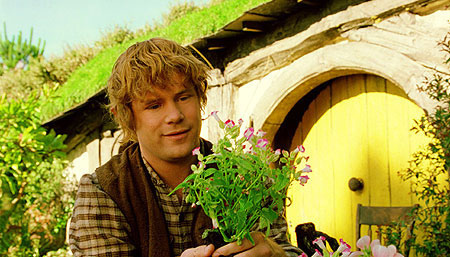
Throughout history it was completely normal for homes to have some sort of garden from which they grew food, in addition to the farmlands around their village or town. Whether it was a small herb or kitchen garden, or a larger space producing the entire household’s food, it was a regular part of life.
How odd is it that, in our current times, it’s completely unusual to have a garden? We have grown so use to not having them, the idea of planting, even a small one, can be an intimidating thought. I’ve talked with many friends who impressed upon me their fears on starting their own garden. The consensuses was, they never took the step to start one because they didn’t know where to begin, or didn’t think they were born with a “natural” green thumb.
The good news is, you don’t have to be born with a green thumb to plant and maintain your own garden. The secrete to gardening is simply learning through trial and error. Your green thumb grows as you progress.
When I first started dabbling with growing edibles, I didn’t have a clue has to what would work and what wouldn’t. Because I lived in a downtown city location, anything I planted had to go into pots, for lack of yard space. And let me tell you, every single tomato plant I bought did not produce one tomato. Advice from friends revealed I had been over watering. The next year I planted tomatoes in the same pots and they produced! Only, this time a family of mocking birds decided my plants where their personal buffet and ate them before I could pick any.
While my success with tomatoes wasn’t the greatest, I found I did really well with herbs. So the year after that, I concentrated on just growing herbs. And within that category, I further studied what did well and what didn’t. What I learned was, it was best to start out small, to get a feel for what works for you, your schedule, and your climate, then expand your garden from there.
Since first planting my doomed tomatoes and considering myself the bringer of death to all plants, I have completely done a 360. My small success with herbs gave me the confidence I needed to expand to other things. Soon I had all kinds of pots filled with herbs, vegetables, fruits, and flowers. Before I knew it, I took a job at an organic farm to further learn what plants work best in my area. And, now that I have a home of my own, I can finally begin planting in-ground.
If you’re like me, and question whether you have what it takes to plant and maintain a garden, be encouraged! Start out small and get a feel for what plants work for you. A small herb garden is surprisingly easy to create and even easier to maintain. Having just planted my own small herb garden, I have included details on the process below:
- Pick a location – Partly sunny to full sun is best, but if you have mostly shade, there are herbs that will work with that. My own location is in full sun.
- Pick your plants – If this is your first time starting a garden, choose easy-to-grow plants (such as Rosemary). Mine has Rosemary, Sage, Lemon Thyme, and Greek Oregano.
- Chose your layout – Make sure to take into consideration which plants go best next to each other. Most herbs go well with each other, but if you are unsure, Google it. For instance, sage goes well with Rosemary, but it doesn’t like to get crowded. I made sure to give my Sage lots of space. My layout consists of a pea stone path lined on both sides. The path will eventually lead to the gate of a larger fenced garden.
- Shop for supplies – Thanks to a tip from a friend, I walked away from a sale with all 6 herb pots for only USD $14. The edging I used around the garden space and walkway isn’t glamorous but it gets the job done and helps keep the grass form encroaching on the herb beds. If you are on a tight budget like me, look for sales and gather supplies when able until you have all you need.
- Pick a date and dig in! – Spring is best, as it gives plants the time they need to acclimate to the soil conditions around them. If you do plant in summer, you might need to be more attentive with watering so the roots don’t dry out. While I planted my herb garden out of necessity in mid-summer, I will be laying the ground work for my large garden this fall when the weather is cool, then prep it for planting in the early spring.
- Thankfully, I had some help from a good-looking Scotsman. Donovan and I switched turns digging up the grass. Yay for 100+ F degree heat…
- Once the grass was cleared and the outline dug, we began installing the edging. The extra grass and sod will be used to fill in bare spots or holes around the yard.
- After the edging was installed, we worked to level the ground.
- Once the ground was leveled, we installed the landscaping fabric to keep weeds at bay within the walkway.
- Pea gravel was my choice for the walkway, so that went down after the landscaping fabric was installed.
- Once all of the ground work was completed, the fun part was next – planting the herbs! Front to back: Rosemary, Sage, Lemon Thyme, and Greek Oregano. Project completed in about 3 hours time.
The end of the summer is the perfect time to begin planning next year’s garden! I would love to hear from any of you who decide to try your own hand at it. Share your own gardening experiences, questions, or future plans in the comment section below. Happy gardening!


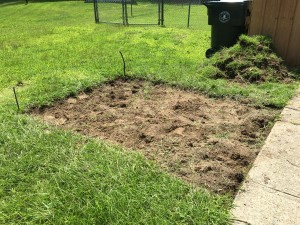
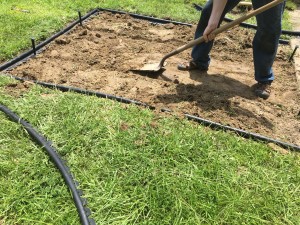
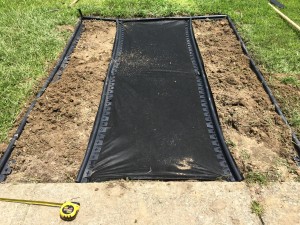
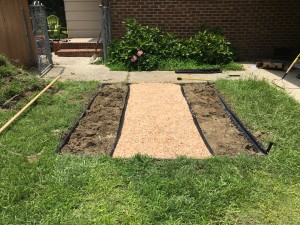
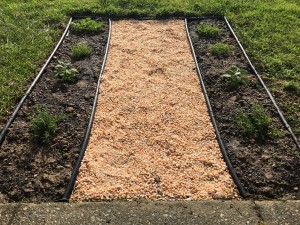


One Comment